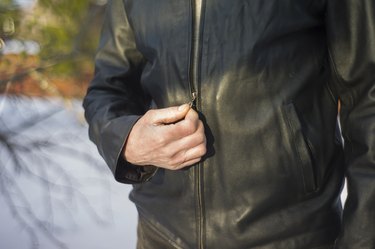Switching over your closet from lightweight summertime fabrics, like cotton and polyester, to heavier ones, like flannel and leather, signals the coming of fall. Those warm fabrics come with their own special set of care instructions. Delicate fabrics should be worn sparingly, while other clothing items are durable enough to withstand daily wear.
Don't panic if you're not sure how to maintain that new knit beanie or suede jacket because we're here to help make washing clothes on laundry day easier. From what temperature of water to use to which wash cycle is best, we've got you covered with laundry tips and laundry hacks on all fronts.
Video of the Day
Video of the Day

1. Scarves
A scarf is an essential part of any cold-weather outfit and should be washed often. You might think it's safe to skip washes, but a scarf hits the bottom of your face and will soak up makeup and oils with ease. Add a splash of distilled white vinegar to the next load of laundry for a natural fabric softener alternative that won't break down fibers. If you have a bright-colored scarf, toss a color catcher sheet in the washing machine with it to prevent any dye from transferring to the other clothes in the load.

2. Hats
Keep your favorite winter hats smelling fresh with regular washes since the inner rim will get dirty pretty quickly thanks to all the oils on the forehead. Wash hats on a gentle cycle or hand wash them. Either way, the drying method should always be the same. Lay out your hat flat and air dry it to maintain its size and shape.

3. Gloves
When you consider how many surfaces you touch each day, you can only imagine how many germs are trapped in the fibers of your gloves. The inside of your gloves isn't any better thanks to the perspiration from your hands, so be sure to lay out the gloves on a drying rack between uses to avoid any bad smells. They should be given a hand wash and then air dried to prevent any shrinkage.

4. Down Feather Jackets
Puffy down feather jackets and vests don't have to be washed very often. Overwashing can actually cause the feathers inside your jacket to break down. Once or twice during the winter season is enough since they are usually the last layer of your outfit. Wash your down feather jacket with gentle laundry detergent and cold water to prevent the feathers from getting flat. It's also a good idea to tumble dry it on low along with a few clean tennis balls to re-puff your beloved jacket.

5. Flannel
Different fabrics require different methods of care, and flannel is no different. Flannel sweaters will need to be washed more frequently than a flannel jacket, but either way, this gentle fabric requires a bit more maintenance. It's best to wash any flannels you have with warm water to ensure the colors don't fade. Putting your flannels in the washer by themselves helps keep your other clothes from being covered in tiny balls of lint.

6. Leather Jackets
A leather jacket is an investment, so making sure you know how to properly clean it in the event of an accidental spill is crucial. Obviously, trying to avoid spills and stains is always best, but life happens. If you do happen to spill something on your leather jacket, blot the spot with a soft sponge and plain water. Be sure to start in the middle of the spot and feather the edges as you work outward to avoid a water ring. If that doesn't help, you can also blot the stain with a diluted, gentle cleanser. However, if you're dealing with either makeup, ink, oil or paint, it's best to call in the professionals for high-powered stain removal.

7. Suede
When it comes to suede, it's usually best to leave the heavy lifting to professional cleaners since it's easy to make a small spill worse. The worst thing for suede is water, so be sure to double-check the forecast before putting on your suede boots or jacket. A few drops of rain won't do much damage, but you wouldn't want to be caught in a downpour.

8. Wool Coats
If your wool coat is something you wear on a daily basis, washing at the beginning and the end of the season should be sufficient. A soft brush will help remove debris and lint from the surface of the coat, and it should be used after every wear. When storing your coat between wears, choose a strong hanger that will be able to support the weight of the coat without stretching out the shoulder area. Make sure your coat closet isn't packed too tightly since wool can be easily crumpled and will absorb smells and dirt from nearby items. When the season is over, store your wool items in zippered garment bags to deter moths and other insects from infesting the fabric.

9. Chunky Knits
Chunky knit sweaters and hats are cold weather must-haves, but they also come with specific needs when it comes to washing. The main goal when washing knits is to have as little friction as possible to avoid pilling. Hand washing is always best, but sometimes, it's just not realistic. For the times when you must machine wash, opt for the most gentle cycle and the shortest cycle your washing machine offers. Never use hot water — that's important. When the washing is done, don't even think about putting it in the dryer. Instead, reshape it and lay flat to air dry.

10. Fleece
Fleece is know for being soft and cozy, so it's only natural that you'd gravitate toward it on frigid days. When it comes time to wash your favorite fleece pieces, cold water is best. You'll also want to avoid bleach and any kind of fabric softener. Wash fleece items inside out to prevent pilling and tumble dry on low heat. This is actually one fabric where it's recommended that you don't dry clean the item.
